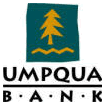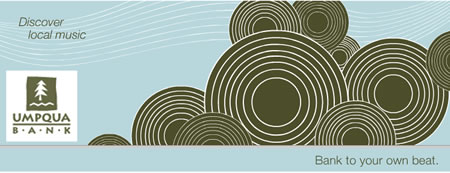 There’s a bank in Portland, Oregon called Umpqua, and they’ve hit on a clever way to build their brand – and their deposits. No, they don’t give away toasters, they don’t have catchy jingles, and they don’t have celebrity spokespeople.
There’s a bank in Portland, Oregon called Umpqua, and they’ve hit on a clever way to build their brand – and their deposits. No, they don’t give away toasters, they don’t have catchy jingles, and they don’t have celebrity spokespeople.
They’re doing it with local music.
As a way of differentiating themselves from the mega-banks, Umpqua is using what they call the "community hub" to set themselves apart from their many competitors. (It’s the same system used by Ritz-Carlton that emphasizes service over just about everything else.)
Working with Rumblefish, the bank helped put together more than 200 songs from local indie bands. While originally designed as a marketing tool to attract young customers, test CDs revealed that just about everyone was interested in hearing music from area artists. It led to one local band, Rye Hollow, doing a multi-city tour around the bank’s markets. This has led to the bank building a web site where users can listen to clips, build local music CDs, and buy them. The bank splits the profits with the bands. From there, the bank released its first local music CD, "Discover Local Music: Vol. 1, Sacramento to Seattle," available at Umpqua locations.

What does this tell us?
First, we continue to see in L.A.B. group after L.A.B. group that local music is highly desirable. When it comes to that section of the discussion where listeners tell us how WAAA can get better, "play and expose more local music" always comes up. Why not begin to ask these same questions in quantitative surveys?
Second, local music isn’t just for Alternative stations. Case in point: the "Mitch Albom Show," on WJR/Detroit. Mitch regularly features local music, live in the studio, on his shows. They provide the "bumper music," and Mitch showcases them throughout the show, and on his web site. Featured artists are from multiple genres, from rock to jazz to reggae.
Third, let’s go back to Jason Calacanis’ session at Summit 11. Clearly, he sees the potential to create podcasts that build radio brands, while generating revenue. The problem, of course, with music-focused blogs is that stations do not have the ability to feature most of the artists they play. But with local artists, those roadblocks can be eliminated by putting together a profit-share system that benefits both stations and performers. The station gets credit for supporting local music, the bands get exposure, and both sides derive revenue from sponsorships and sales (on the web site, of course).
Fourth, your station web site is the perfect community meeting place for bands to exchange music, for listeners to gain exposure to local bands, and for music to be bought and sold. If a bank can do it, so can you.
Finally, this is all proprietary stuff. It’s music that listeners cannot hear on XM or Sirius, or streaming on KCRW or some Australian station. It’s bands that the audience probably won’t see on iTunes or have access to on Pandora. And it supports the local community, which is of course, the essence of what got radio to the dance in the first place.
If the only thing that stations do to serve that community music need is the Sunday night "local licks" show, it may be time to rethink the approach. For all the right reasons.
- For Radio, Will It Be Christmas In April (And Hopefully, May)? - April 21, 2025
- Media And Technology In 2025: Believe It Or Not! - April 18, 2025
- In Radio, You Just Never Know - April 17, 2025




thought sirius was working with a few partners on some type of indie music program, which should launch this year yet for distribution over all digital platforms
im really glad to see the indies getting some play while being paid….